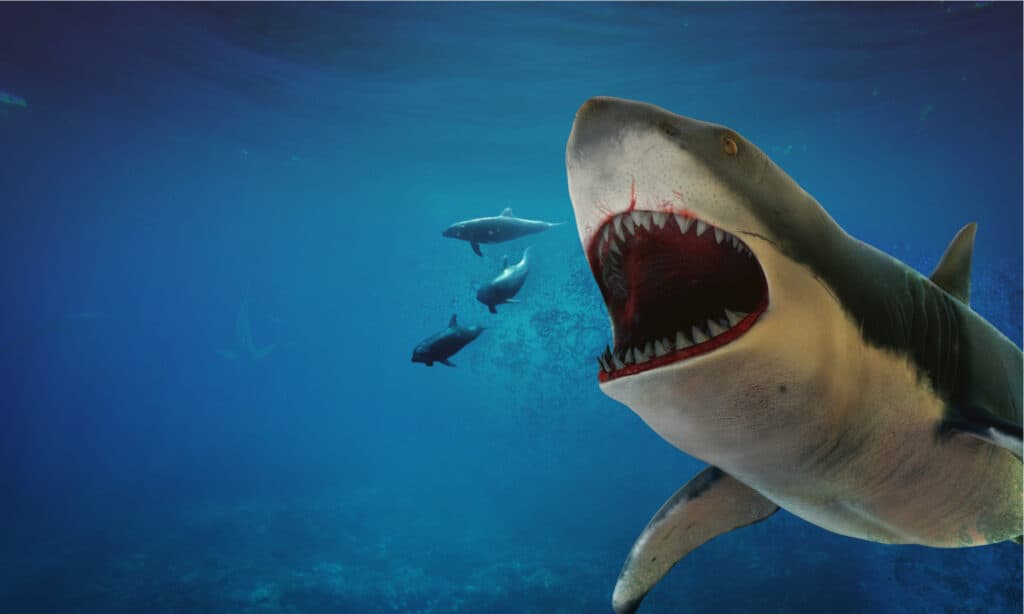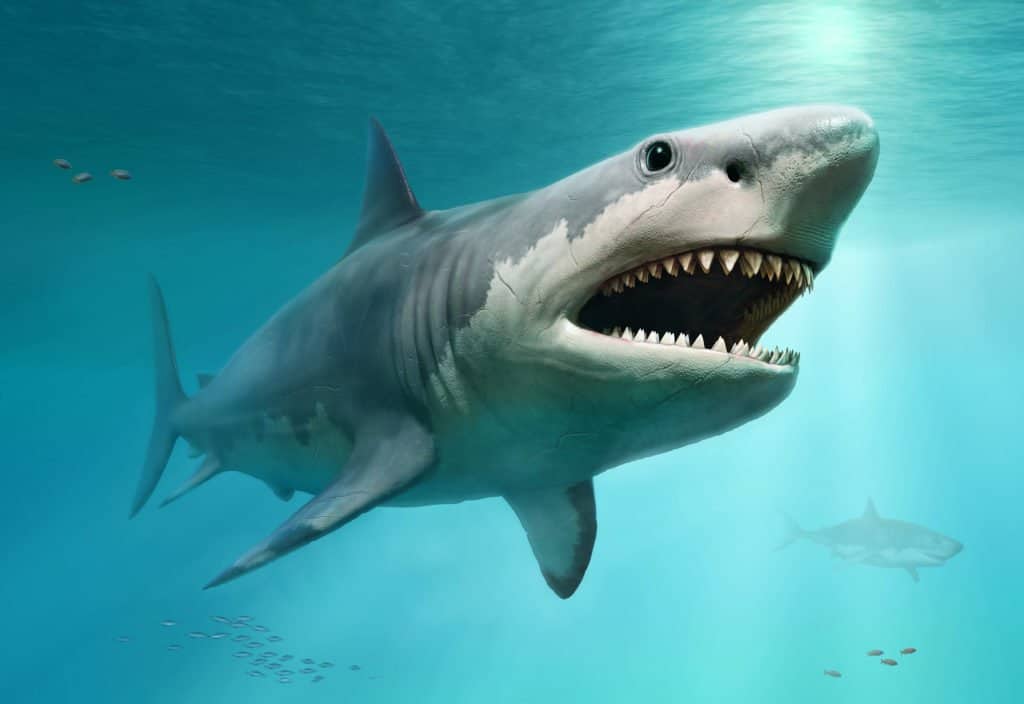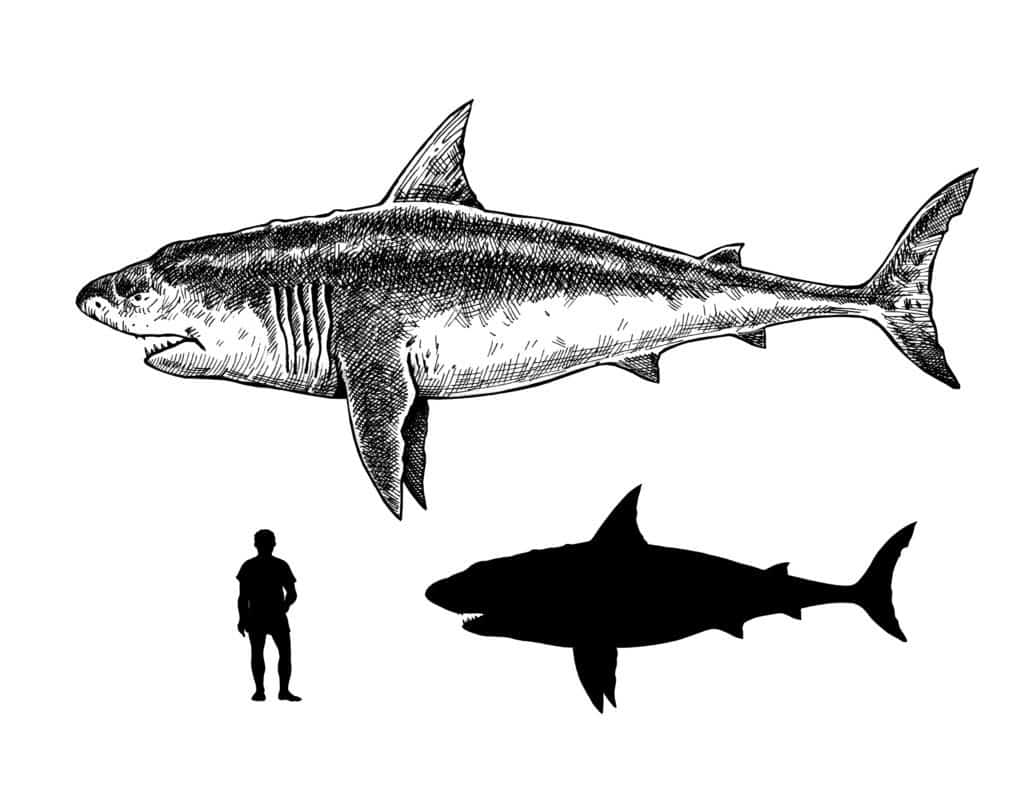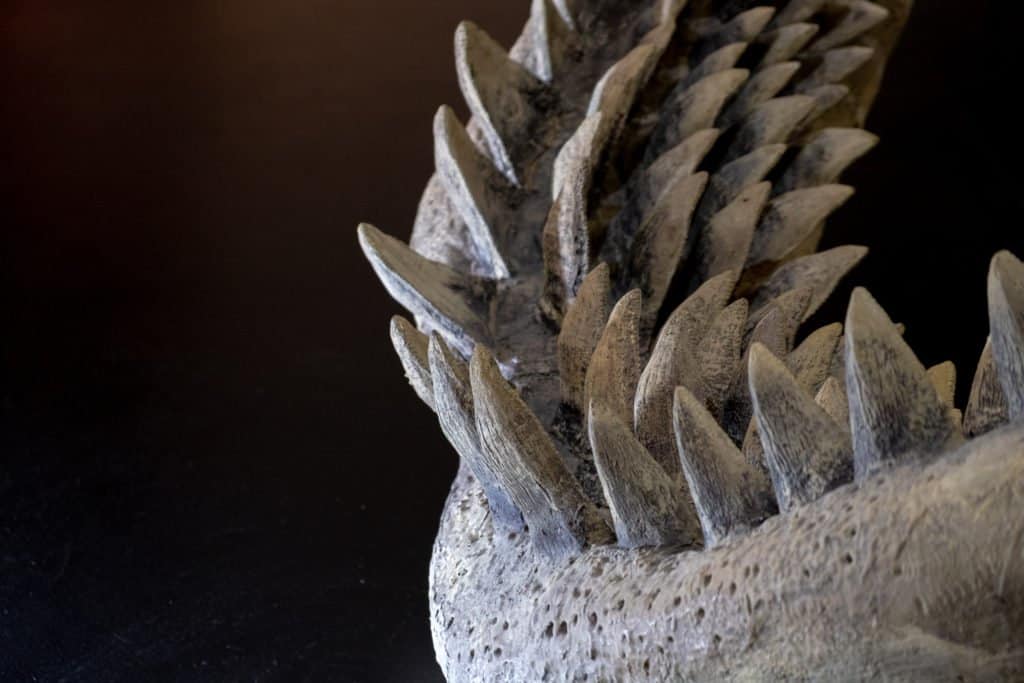Megalodon
Otodus megalodon
The largest shark to ever exist! Over 50 feet long and up to 100X the mass of today's great whites!
Advertisement
Megalodon Scientific Classification

Megalodon Facts
- Prey
- Baleen whales, toothed whales, sea turtles, sharks
- Main Prey
- Baleen whales
- Group Behavior
- Solitary
- Fun Fact
- The largest shark to ever exist! Over 50 feet long and up to 100X the mass of today's great whites!
- Estimated Population Size
- Extinct
- Habitat
- Coastal ocean waters
View all of the Megalodon images!

The megalodon was the largest shark to ever live.
With a size that could reach in excess of 50 feet and estimates for its weight stretching beyond 100,000 pounds, the megalodon was significantly larger than any other shark species on record. Learn about the largest ocean animals to have ever lived here.
Incredible Megalodon Facts!

Megalodon shark hunt some dolphins.
©Antonio Viesa/Shutterstock.com
- In January 2019 video of a great white shark nicknamed “Deep Blue” made world news thanks to the shark’s incredible size. It was estimated “Deep Blue” was one of the largest great white sharks ever recorded, weighing in at 2.5 tons. As you’ll read below, estimates for megalodon size reach 20 to even 50 times the size of today’s largest great white sharks!
- The highest bite force of living shark species today has been measured at 18,216 newtons. A recent 3-D computer analysis placed the megalodon’s bite force at up to 182,201 newtons! That’s more than five times the bite force estimates for a Tyrannosaurus Rex!
- While megalodons were incredible apex predators, the latest fossils on record date back no later than 2.6 million years ago. We’ve compiled a full list of scientific theories on why the megalodon may have gone extinct below!
Want the most mind-blowing megalodon facts? Check out ‘13 Mind-Blowing Megalodon Facts‘ to get the most incredible facts about this prehistoric giant!
Scientific Name

Megalodons are an extinct species of sharks that grew to more than 50 feet in length.
©Warpaint/Shutterstock.com
The scientific name of the megalodon shark is Otodus megalodon.
With megalodon teeth reaching beyond 6 inches in length, discoveries of megalodon teeth in the middle ages were often thought to be dragons or other mythical creatures.
The first scientific name for megalodon was Carcharodon megalodon. Megalodon was placed in the genus Carcharodon – a genus that includes today’s great white shark – due to similarities in its teeth structure.
However, the current scientific consensus places megalodon in the family Otodontidae. There continues to be debate surrounding megalodon’s exact classification, so the genus of the species could change in the future barring further research and fossil discoveries.
Evolution and Origins
The oldest fossils of the megalodon shark, also referred to as Otodus megalodon (previously known as Carcharodon or Carcharocles megalodon), is dated to 20 million years ago and they continued to exist for the next 13 million years, ruling the oceans until they went extinct about 3.6 million years ago.
Megalodon had a worldwide distribution and its fossils have been found in numerous locations around the globe, including Europe, Africa, the Americas, and Australia. The shark was usually found in areas with subtropical to temperate climates.
Furthermore, the megalodon shark’s predecessors include Otodus obliquus, which had smooth teeth with thick roots and two mini-teeth, and Carcharocles auriculatus, which had serrated teeth with two mini-teeth.
Appearance and Behavior

The Megalodon was a massive species of shark. Since the first discoveries of its teeth, scientific debate has raged around the megalodon’s size (a summary of scientific findings can be found below). Like most large fish, it’s believed megalodon exhibited dimorphism where females grew significantly larger than males.
As sharks have skeletons made of cartilage, most of what we know about megalodon today is based on fossilized teeth that have been found across the world.
While most models and artistic renditions of the megalodon have the species looking very close in appearance to a much larger great white shark, there is some debate that the shape of the species could have more closely resembled other shark species, such as a whale shark (which like the megalodon reaches 50 feet in length).

Megalodon Vs. Great White
©Sammy33/Shutterstock.com
Size
Megalodon’s size has been the subject of significant research, but most studies place its maximum length at around 50 feet (15 to 16 meters). With scientists relying largely on tooth samples that can reach more than 6” in length, various methods have been used to estimate the length and body mass of this enormous shark.
Below, we’ve summarized the key finding of recent scientific research into how large megalodon may have reached:
- A 1996 paper from Gottfried, et al. placed the maximum length of megalodon at an astounding 20 meters (67 feet). In addition, the paper placed a conservative body mass maximum of 47,960 kg (105,733 lbs). The paper also established a maximum body mass of 103,197 kg (227,510 lbs). For perspective, the maximum size of today’s great white sharks is roughly 5,000 lbs!
- A 2019 study from Kenshu Shimada placed the maximum size of megalodon at between 14.2 and 15.3 meters (50 feet).
- In September 2020 a team of researchers from Swansea and the University of Bristol used 2D reconstruction to estimate the megalodon’s size. Their research placed the megalodon’s maximum size at 16 meters (52 feet) with a head that reached 4.65 meters (15 feet) in length!
While female megalodons reached tremendous sizes, males were significantly smaller. Males had a maximum length about 20% shorter than females and may have weighed about half as much on average.
Tooth Size
Megalodon teeth have been discovered on every continent except for Antarctica. The teeth are notable for their size, with the largest samples ever discovered exceeding 7 inches in length! For perspective, larger great white shark teeth range in size from 1.5 to 2.5 inches. Megalodon teeth have been called the “ultimate cutting tools” and possessed serrated edges converging to a pointed end.
Thanks to the discovery of several nearly complete sets of megalodon teeth, scientists have been able to reconstruct the appearance of the megalodon’s jaws and the position of its replacement teeth (see picture below).

Megalodon teeth rows
©ilikeyellow/Shutterstock.com
Today, there are several regions where megalodon teeth can be found in relative abundance. For example, cliff faces in Western Australia are believed to contain “thousands” of megalodon teeth. In the United States, they’ve been frequently spotted in areas like off the coast of Wilmington, North Carolina.
Habitat and Distribution
Like great white sharks today, megalodon was found across the world in non-polar waters, however, their range did expand over time.
The earliest megalodon discoveries in the Early Miocene (about 23 million years ago) are in more concentrated areas along the Baja coast, the Caribbean, the Mediterranean Sea, and Australia. By the Late Miocene (roughly 6 million years ago), the species distribution had expanded across North and South America and was more commonly found in locations like South Africa.
In the Early Miocene, North and South America weren’t connected, which allowed travel between the east and west coasts of the continent. In addition, the Mediterranean opened up to a vast sea that included much of today’s middle east. These shallow seas presented excellent hunting opportunities for the species.
Diet
The Megalodon was an “apex predator” that fed on baleen whales, toothed whales, sea turtles, and even other sharks. Due to its incredibly large size, the megalodon needed to consume a voracious amount of food. It’s estimated that to feed its appetite, the shark would need to consume roughly 2500 pounds of food per day.
(For reference, that works out to a diet requiring eating the mass of 6.5 bottlenose dolphins per day!)
Evidence from fossils shows megalodon was at the top of the food chain, and bite marks attributed to the shark can be found across large whale species such as the sperm whale, which can reach up to 130,000 pounds. However, fossil records indicate megalodon species may have hunted different prey depending on their location, often targeting prey such as dwarf whales and medium-size baleen whales.
Predators and Threats
Fossil records indicate the megalodon is a shark without a peer. A study published in Historical Biology in October 2020 concluded their gigantism was “off the scale” and contemporary sharks in their gamily – Lamniformes – reached no more than 23 feet in length. That means that the megalodon’s size (measured by weight) may have been 10 to 30 times larger than its closest relatives.
Evidence in the fossil record shows that sharks during the time megalodon lived may have avoided the species, preferring colder waters where megalodon didn’t hunt and compete for resources. Yet, even with its incredible size and predatory adaptation, megalodon faced competition.
For example, a toothed whale that lived at the same time as megalodon – Livyatan – hunted in much the same way as today’s killer whales. However, the species was much larger, with dagger-like teeth that could reach more than a foot in length.
Was Megalodon the Largest Predator Ever?
The list of largest predators ever is focused on the water. Modern sperm whales can reach more than 75 feet in length and weigh more than 90,000 pounds. Today, sperm whales hunt prey such as squid, but their ancestor – Livyatan – may have battled megalodons directly.
Another predator that was close in size to megalodon was Mosasaurus. We recently pitted megalodon vs. Mosasarus against one another in a hypothetical battle, and both sea giants had advantages that made this a close fight!
Extinction
A number of theories have been proposed for megalodon’s extinction ranging from climate change to a nearby supernova, to the extinction of its primary prey. We’ll examine the theories of megalodon extinction individually.
Climate change
Megalodon’s range was restricted to more temperate waters. For example, in the northern hemisphere megalodon fossils haven’t been discovered further north than Denmark. The expansion of glaciers at the Earth’s poles – and the resulting loss of shallow, temperate seas — could have led to a reduction in habitats suitable to the megalodon and lessened its population.
Supernova
A study published in the journal Astrobiology in 2018 proposed that a supernova 150 light years from earth killed off more than 1/3 of the world’s large marine animals 2.6 million years ago – and megalodon was one of its victims.
Why would this event have been so harmful to megalodon? The authors of the study estimated a wave of radioactive ‘muons’ would have hit the earth and lasted for a generation, leading to a risk of cancer that increased in larger animals. With estimates of megalodon’s size reaching 100,000 pounds and beyond, it would have been one of the largest animals on earth at the time.
A great white shark extinction?
Finally, an analysis in PeerJ that was published in 2019 proposes that the megalodon’s extinction may have been caused by a much smaller shark: the great white!
The authors of the analysis point to evidence that the megalodon’s extinction may have been earlier than previously believed, about a million years before the supernova that hit the earth and wiped out many large marine animals.
They propose that megalodon populations were already on the decline from climate change and the loss of prey like smaller whales. Adding to the species’ woes, at this time the great white shark evolved and began competing with younger megalodons for prey.
View all 164 animals that start with MMegalodon FAQs (Frequently Asked Questions)
How big is a megalodon?
While there have been many studies and research papers published with differing estimates on megalodon’s size, today most estimates place its maximum length at 14 to 16 meters (46 to 54 feet). Estimates for the weight of megalodon’s vary dramatically as they’re based of extrapolations of the shark’s tooth size. However, more ‘conservative’ estimates place their maximum weight in excess of 100,000 pounds.
Was the megalodon the biggest fish ever?
The megalodon was the largest predatory shark ever found in the fossil record. However, other fish (and even non-predatorysharks) may have grown larger than it. The whale shark, which still exists today and survives on a diet of plankton, typically grows to about 40 feet (13 meters) in length. However a study published in Marine & Freshwater Research Journal found that whale sharks grow up to 61.7 feet!
That length would place them longer than most estimates of megalodon’s size. The largest whale shark was estimated at a weight of about 43,000 pounds, which is below the size of most megalodon estimates.
Another fish that may have exceeded the size of megalodon was Leedshichthys problematicus. Estimates of this ancient fish vary widely as a complete skeleton hasn’t been discovered. However, it’s believed this monstrous fish could reach up to 75 feet in length. At its larger sizes, it’s estimated Leedshichthys weighed up to 100,000 pounds (or 45 metric tons)!
Megalodon vs. Blue Whale: Which was larger?
Estimates for megalodons weight ‘conservatively’ sit at more than 100,000 pounds, but does that make it larger than a blue whale?
Blue whales reach up to 100 feet (30 meters) in length and Antarctic females average around 260,000 pounds, making them larger than even the highest maximum estimates for megalodon weight. The earliest fossil of a ‘modern’ blue whale is approximately 1.5 million years old, so the species evolved after the last megalodon roamed the oceans.
What was a megalodon’s bite force?
A megalodon’s bite force is estimated at more than 10 times the force of a great white shark! The estimate comes from a study in the Journal of Zoology which used 3D computer analysis to determine the megalodon’s bite force.
The study found that the largest great white on record could produce a bite force of 18,216 newtons. Their model placed a ‘conservative’ estimate of megalodon’s bite force at 108,514 newtons, with a maximum estimate of 182,201 newtons!
At the upper range of these estimates, that bite force would translate to 41,000 pounds. Its estimated the bite force of a Tyrannosaurus was 8,000 pounds, and a lion is 1,000 pounds, so the megalodon’s bite had historical force behind it!
Why did the megalodon go extinct?
The short answer is scientists don’t have an answer. The longer answer is that climate change brought about by expanding polar ice created climate change that is believed to have challenged the megalodon’s survival.
From there, scientific theories have been brought forth that competition from great white sharks, a plummeting population of small and medium sized whales the megalodon fed on, and even a supernova that happened 150 light years away 2.6 million years ago all could have led to the ultimate demise of the megalodon.
How big was megalodon compared to prehistoric giants like Titanoboa?
Megalodon was the largest shark to ever live, so you might be wondering how it compares to other prehistoric giants. In a battle of megalodon vs Titanoboa, which was the largest snake to ever live, both animals were roughly the same length. Titanoboa was up to 50 feet long while estimates for megalodon are in the same range. However, when it came to weight megalodon was a far larger creature. While megalodon weighed 100,000 pounds (or more) at its maximum size, Titanoboa was estimated to weigh just 2,500 pounds.
Where can I find megalodon teeth?
Megalodon had more than 250 teeth in its mouth at any given time. The large number of teeth has led to an abundance of fossilized teeth discoveries across the world, but some areas have much higher concentrations. In the United States, try ledges or in shallow creeks near the ocean. Wrightsville beach in North Carolina is known for megalodon teeth, where they’re often found in underwater ledges within 30 miles off the coast. In areas like Virginia’s tidewater that were shallow seas millions of years ago, megalodon teeth can often be found along rivers days after storms erode banks and reveal fossilized remains that have long been buried underground.
Are Megalodons herbivores, carnivores, or omnivores?
Megalodons are Carnivores, meaning they eat other animals.
What Kingdom do Megalodons belong to?
Megalodons belong to the Kingdom Animalia.
Who would win a fight between a megalodon and a whale shark?
A megalodon would decisively win a fight against a whale shark. This massive fish has every reason to win and none to lose. Not only does it have a size and speed advantage, but it is also an actual killer, unlike the whale shark.
Thank you for reading! Have some feedback for us? Contact the AZ Animals editorial team.
Sources
- Kenshu Shimada / Published June 29, 2020
- Phys Org
- Cooper et al. / Published September 3, 2020
- Wroe et al.

















